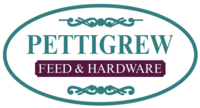Why Fresh Feed Matters (and How to Store It the Right Way)

🐓 Why Fresh Feed Matters (and How to Store It the Right Way)
Whether you’re raising backyard chickens, caring for cattle, or keeping pets happy at home, one thing is true everywhere: fresh feed matters.
At Pettigrew Feed & Hardware in Edinburg, Ohio, we see it every season — customers who store their feed properly have healthier animals, less waste, and fewer headaches. And the good news? These same principles apply nationwide, no matter your climate or setup.
Here’s why freshness counts — and how to store feed the right way this fall and winter.
1. Fresh Feed = Better Nutrition
Animal feed is full of vitamins, proteins, fats, and minerals that fuel growth, egg production, weight gain, and overall health. But just like human food, feed loses nutritional value the longer it sits.
-
Chickens need high-quality protein for steady egg production.
-
Cattle rely on balanced nutrients for strong calves and healthy weight.
-
Pets do better with crisp, nutrient-rich kibble, not stale crumbs.
At Pettigrew, we take freshness seriously. We receive more than 40 tons of feed every week, all of it stored in a dry, sealed environment. Every shipment is carefully rotated so the feed you take home is the same quality we’d feed to our own animals.
2. Moisture & Mold Are the Enemy
Feed and humidity don’t mix. In Northeast Ohio, fall brings chilly nights, warm afternoons, and plenty of dampness — conditions that encourage mold growth if feed isn’t stored properly.
This isn’t just a local issue. Across the U.S., from muggy Southern barns to cool New England sheds, feed that’s exposed to moisture can spoil fast. Moldy feed isn’t only wasteful — it can make animals sick.
The fix is simple: keep feed in a dry, sealed container and never leave bags sitting open in the barn.
3. Keep Pests Out
Rodents and wildlife are opportunistic. Mice, rats, squirrels, even raccoons will tear into an open feed bag if given the chance, contaminating it with droppings or chewing holes straight through the packaging.
That’s why proper storage containers are essential. Galvanized metal cans with tight lids, heavy-duty plastic bins, or sealed feed totes all keep pests out. Pettigrew carries multiple storage solutions in-store and online so your feed stays safe and clean.
4. Buy What You’ll Use in 30–60 Days
Fresh feed means manageable portions. Instead of stockpiling months of feed at once, buy what your animals can use in about 30 to 60 days. This keeps feed at peak nutrition and prevents waste.
We practice the same standard at Pettigrew. With weekly deliveries and strict inventory rotation, you never have to worry about feed sitting around for months. What you buy from us is always fresh.
5. Follow the FIFO Rule (First In, First Out)
A tried-and-true system for freshness:
-
Use your oldest feed first.
-
Label bags with the purchase date.
-
Empty bins completely before refilling with new feed.
This simple step ensures consistency in your animals’ diet and helps avoid spoilage.
6. Different Animals, Different Needs
Freshness matters for every species — but so does choosing the right formula:
-
Poultry: Scratch grains, layer feed, or starter crumbles depending on age and purpose
-
Cattle: Pellets, cubes, or textured feed balanced for protein and growth
-
Horses: Sweet feed, complete feed, or supplements for coat and hoof health
-
Pets: High-quality kibble that stays crisp and palatable
Our staff at Pettigrew is always happy to guide you in choosing the best option. We stock a wide variety of livestock and pet feeds, all kept fresh through our weekly shipments and careful rotation.
7. Seasonal Storage Tips for Northeast Ohio (and Beyond)
Fall and winter in Ohio mean fluctuating temperatures and heavy moisture — two things feed doesn’t like. A few best practices:
-
Store feed off the floor on pallets or shelves
-
Keep it in a dry, well-ventilated space
-
Avoid outdoor storage, even under tarps — condensation sneaks in
-
Use sealed bins or cans for added protection
These rules apply anywhere, but they’re especially important in our region where lake-effect snow and damp barns can make conditions tricky.
Final Thoughts
Feed isn’t just fuel — it’s the foundation of your animals’ health. By keeping it fresh, dry, and protected, you’ll get the most out of every bag while ensuring your animals stay healthy and strong.
At Pettigrew Feed & Hardware in Edinburg, Ohio, we back up that promise with action: over 40 tons of feed delivered fresh every week, stored in a sealed environment, and rotated constantly for peak quality.
Shopping local? Visit us in Edinburg for fresh feed, airtight containers, and expert advice.
Shopping from afar? Browse our online store and have Pettigrew’s quality delivered right to your door.
Because no matter where you are, fresh feed makes healthier, happier animals.
- Wesley Willis
